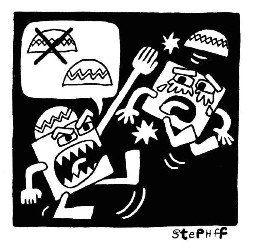At the end of the lesson, students will be able to:
- interpret an editorial cartoon.
- understand the meaning of tolerance and the effects of intolerance.
- develop and create their own poster-sized cartoon to promote tolerance and social justice.
- Why do artists create editorial cartoons?
- How are editorial cartoons different from other kinds of art and media?
Enduring Understandings
- Artists create editorial cartoons to express their opinions about society and events in the news.
- Editorial cartoonists often use line drawings of symbols in society to convey their messages.
A projector or interactive whiteboard showing the cartoon featured in this lesson, or copies of the cartoon to be distributed to all students
Vocabulary
tolerance [tä-lə-rən(t)s] (noun) an understanding of the practices and beliefs of others, even if they are different from your own
Suggested Procedure
Project or make copies for each student of the editorial cartoon below. Then, as a class, analyze the cartoon by asking the following questions:

Artist: Peray, Thailand. Reprinted with Permission. Teachers may purchase individual cartoons for other lesson plans at PoliticalCartoons.com
Direct students to look at the top of each character. Ask:
- What is similar about the design on each character’s head? What is different?
- What is the character on the left “saying” to the character on the right?
- How do you think this artist feels about intolerance?
- What is the point is the cartoonist trying to make?
Activities
1. Divide students into small groups. Ask each group to come up with examples of tolerance and intolerance.
2. Have each group discuss the following questions:
- What does intolerance do to people?
- What does it mean to be a tolerant person?
3. Ask each group to work together to create a poster in the same style as the editorial cartoon above. Encourage students to rely solely on images and symbols (without text), and tell them that their cartoons must clearly send people a message about how the group thinks about intolerance.
4. Have students present their posters to the class, explaining the symbols they selected and how their poster promotes tolerance.
Extension Activity
Arrange for students to place their posters around the school and community and/or share them on social media.
Common Core State Standards: CCSS SL.1, CCSS SL.2, CCSS SL.3, CCSS SL.4, CCSS SL.5
